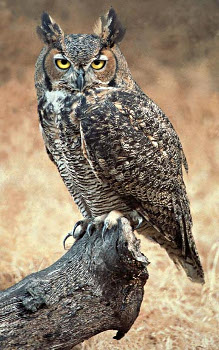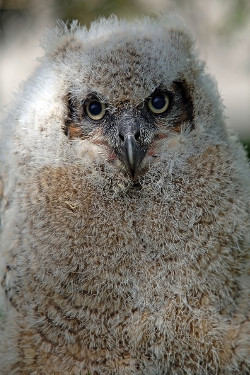Great Horned Owl

Great Horned Owl Information
Length: 18 - 25"
Habitat: Forests, open country, large woodlots, agricultural areas, streamsides, swamps, large suburban parks. Prefers woodlands with nearby open areas for hunting.
Diet: Rabbits, hares, rodents (staples); other mammals such as opossums and skunks; ducks, grouse, pheasants, crows, songbirds; snakes, amphibians, insects
![]() Song and calls of the Great Horned Owl
Song and calls of the Great Horned Owl![]()
Additional Information
Great Horned OwlHabitat, diet, feeding behavior, nesting, migration, and conservation status of this bird. Includes range map, photos, and calls. (From Audubon Field Guide)
Great Horned Owlet

© T. Theodore
Great Horned Owl
Identification Tips
- Wingspan: 55 inches
- Sexes similar
- Very large owl with prominent ear tufts
- Yellow eyes and dark bill
- Upperparts mottled brown, gray, and black
- Pale underparts with fine brown bars
- Reddish-brown facial disks bordered by black with a lower border of white
- White throat patch
- Pale gray form inhabits northern Canada
(Credit: U. S. Geological Survey)
Range in New England
The Great Horned Owl is found year round throughout New England, although in greater numbers in some areas of the region than others.
According to data from the North American Breeding Bird Atlas, there has been a strong decline in the population of this owl in the state of Vermont in recent years.
Great Horned Owl
Range Maps from Cornell
Great Horned Owl year-round range![]()
Includes separate map of sightings.